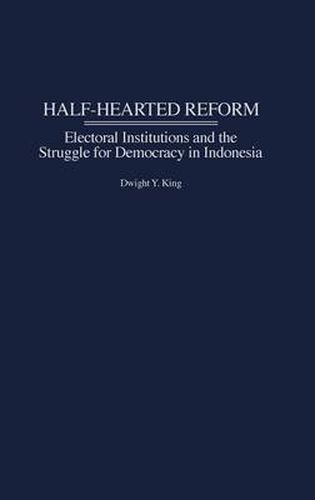Readings Newsletter
Become a Readings Member to make your shopping experience even easier.
Sign in or sign up for free!
You’re not far away from qualifying for FREE standard shipping within Australia
You’ve qualified for FREE standard shipping within Australia
The cart is loading…






King provides the most comprehensive analysis to date of the reforms in the core institutions of democratic representation, political parties, elections, and legislatures that led the way from late 1998 through 2001. These reforms are placed in historical perspective, compared both with the electoral institutions of Suharto’s New Order and with the first democratic election in 1955. King also examines the political struggles during the legislative process and identifies the compromises reached between hardliners and reformers. The new electoral policies are juxtaposed to actual practices-imlpementation-during the 1999 election at both the national and subnational levels, the latter through a case study in the heartland of Java.
The bases of voters’ choice-election results-are explained using multivariate analysis. A key finding is that social-based voting has remained stronger than expected. King’s analysis then considers the postelection, second wave of electoral reform that focused on the Electoral Commission and amendments to the Constitution. Lastly, King compares Indonesia’s political reforms with those of the Philippines and Thailand. In sum, this book is indispensable to understanding the extent of Indonesia’s political reforms, why the installation of electoral democracy succeeded, and the prospects for the consolidation of democracy. Of particular interst to scholars, students, and other researchers interested in political transitions in general and in Southeast Asia in particular.
$9.00 standard shipping within Australia
FREE standard shipping within Australia for orders over $100.00
Express & International shipping calculated at checkout
King provides the most comprehensive analysis to date of the reforms in the core institutions of democratic representation, political parties, elections, and legislatures that led the way from late 1998 through 2001. These reforms are placed in historical perspective, compared both with the electoral institutions of Suharto’s New Order and with the first democratic election in 1955. King also examines the political struggles during the legislative process and identifies the compromises reached between hardliners and reformers. The new electoral policies are juxtaposed to actual practices-imlpementation-during the 1999 election at both the national and subnational levels, the latter through a case study in the heartland of Java.
The bases of voters’ choice-election results-are explained using multivariate analysis. A key finding is that social-based voting has remained stronger than expected. King’s analysis then considers the postelection, second wave of electoral reform that focused on the Electoral Commission and amendments to the Constitution. Lastly, King compares Indonesia’s political reforms with those of the Philippines and Thailand. In sum, this book is indispensable to understanding the extent of Indonesia’s political reforms, why the installation of electoral democracy succeeded, and the prospects for the consolidation of democracy. Of particular interst to scholars, students, and other researchers interested in political transitions in general and in Southeast Asia in particular.